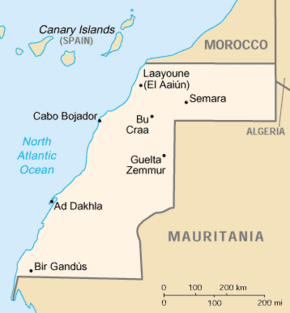
Western Sahara is a disputed territory on the northwest coast of Africa. About 20% of the territory is controlled by the Sahrawi Arab Democratic Republic (SADR); the remaining 80% of the territory is occupied and administered by neighboring Morocco. It has a surface area of 266,000 square kilometres (103,000 sq mi). It is the second most sparsely populated country in the world and the most sparsely populated in Africa, mainly consisting of desert flatlands. The population is estimated at just over 500,000, of which nearly 40% live in Morocco-controlled Laayoune, the largest city in Western Sahara.

The politics of Western Sahara take place in a framework of an area claimed by both the partially recognized Sahrawi Arab Democratic Republic and Morocco.
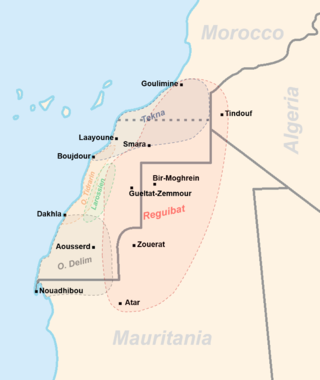
The Sahrawis, or Sahrawi people, are an ethnic group native to the western part of the Sahara desert, which includes the Western Sahara, southern Morocco, much of Mauritania, and along the southwestern border of Algeria. They are of mixed Hassani Arab and Sanhaji Berber descent, as well as West African and other indigenous populations.

Spanish Sahara, officially the Spanish Possessions in the Sahara from 1884 to 1958, then Province of the Sahara between 1958 and 1976, was the name used for the modern territory of Western Sahara when it was occupied and ruled by Spain between 1884 and 1976. It had been one of the most recent acquisitions, as well as one of the last remaining holdings, of the Spanish Empire, which had once extended from the Americas to the Spanish East Indies.
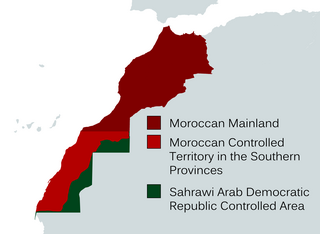
The Southern Provinces or Moroccan Sahara are the terms utilized by the Moroccan government to refer to the disputed territory of Western Sahara. These designations encompass the entirety of Western Sahara, which spans three of Morocco's 12 top-level administrative regions. The term "Southern Provinces" is frequently used on Moroccan state television.
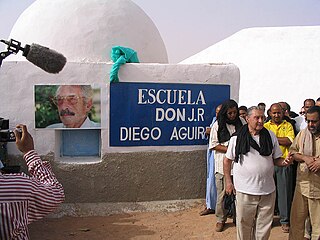
Bir Lehlou is an oasis town in north-eastern Western Sahara, 236 km from Smara, near the Mauritanian border and east of the border wall, in Polisario Front-held territory. It has a pharmacy, a school and a mosque. It is the head of the 5th military region of the Sahrawi Arab Democratic Republic and was the factual temporary capital of SADR until Tifariti became the temporary capital in 2008. It is also the name of a Daïra of the Wilaya of Smara, in the Sahrawi refugee camps.

Tifariti is an oasis town and the temporary capital of the Sahrawi Arab Democratic Republic, located in north-eastern Western Sahara, east of the Moroccan Berm, 138 km (86 mi) from Smara and 15 km (9 mi) north of the border with Mauritania. It is part of what Polisario Front calls the Liberated Territories and Morocco call the Buffer Zone. It has been the de facto temporary capital of the Sahrawi Arab Democratic Republic since the government moved there in 2008 from Bir Lehlou. It is the headquarters of the 2nd military region of the SADR.

The Free Zone or Liberated Territories is a term used by the Polisario Front government of the Sahrawi Arab Democratic Republic, a partially recognized sovereign state in the western Maghreb, to describe the part of Western Sahara that lies to the east of a 2,200-kilometre (1,400 mi) border wall flanked by a minefield, often referred as the Berm, and to the west and north of the borders with Algeria and Mauritania, respectively. It is controlled by the Sahrawi Arab Democratic Republic, as opposed to the area to the west of the Berm, which is controlled by Morocco as part of its Southern Provinces. Both states claim the entirety of Western Sahara as their territory.
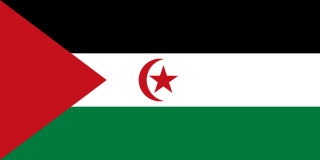
The flag of Western Sahara, also known as the flag of the Sahrawi Arab Democratic Republic, uses a national flag consisting of a black, white and green horizontal tricolor charged with a red star and crescent in the center stripe and a red chevron at the hoist. It is used on SADR-controlled areas, while the Moroccan flag is used on the occupied parts of Western Sahara.
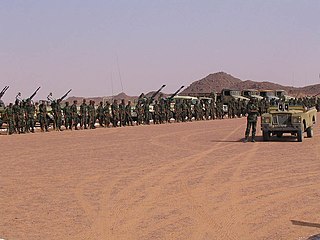
The Western Sahara conflict is an ongoing conflict between the Sahrawi Arab Democratic Republic/Polisario Front and the Kingdom of Morocco. The conflict originated from an insurgency by the Polisario Front against Spanish colonial forces from 1973 to 1975 and the subsequent Western Sahara War against Morocco between 1975 and 1991. Today the conflict is dominated by unarmed civil campaigns of the Polisario Front and their self-proclaimed SADR state to gain fully recognized independence for Western Sahara.

The foreign relations of the Sahrawi Arab Democratic Republic (SADR) are conducted by the Polisario Front, which maintains a network of representation offices and embassies in foreign countries.

The politics of the Sahrawi Arab Democratic Republic refers to politics of the Polisario Front's proclaimed Sahrawi Arab Democratic Republic, a country in North Africa with limited recognition by other states, controlling parts of the Western Sahara region.

The coat of arms of the Sahrawi Arab Democratic Republic is a symbol created by the Polisario Front, the national liberation movement of Western Sahara. The Polisario Front proclaimed the Sahrawi Arab Democratic Republic on February 27, 1976, and both the flag and the coat of arms were adopted as state symbols.

Sahrawi nationality law is the law of the Sahrawi Arab Democratic Republic's (SADR) governing nationality and citizenship. The SADR is a partially recognized state which claims sovereignty over the entire territory of Western Sahara, but only administers part of it. The SADR also administers Sahrawi refugee camps.

The following outline is provided as an overview of and topical guide to the Sahrawi Arab Democratic Republic:

Mexico–Sahrawi Republic relations are the current and historical relations between Mexico and the Sahrawi Arab Democratic Republic (SADR). Mexico recognized the SADR on 8 September 1979.

The Sahrawi Arab Democratic Republic, also known as the Sahrawi Republic and Western Sahara, is a partially recognized state, recognised by 46 UN member states and South Ossetia, located in the western Maghreb, which claims the non-self-governing territory of Western Sahara, but controls only the easternmost one-fifth of that territory. Between 1884 and 1975, Western Sahara was known as Spanish Sahara, a Spanish colony. The SADR is one of the two African states in which Spanish is a significant language, the other being Equatorial Guinea.

Sahrawi nationalism is a political ideology that seeks self-determination of the Sahrawi people, the indigenous population of Western Sahara. It has historically been represented by the Polisario Front. It came as a reaction against Spanish colonialist policies imposed from 1958 on, and subsequently in reaction to the Mauritanian and Moroccan invasions of 1975.

Sahrawi Arab Democratic Republic–Spain relations are the current and historical relations between the Sahrawi Arab Democratic Republic and Spain.
